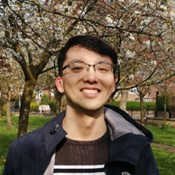Disorder in Nanophotonics: Blessing or Curse?
Speaker: Dr Changxu Liu

Changxu is a Lecturer at the Electronic Engineering, University of Exeter. He is part of the Nano Engineering Science and Technology (NEST) and the Centre for Metamaterial Research and Innovation (CMRI). Prior joining this position, he was an Assistant Professor at Northumbria Unviersity, UK. Before that, he worked as a Humboldt Research Fellow and LMU incoming Research Fellow at Ludwig Maximilian University of Munich, Germany and Postdoctoral Fellow at University of Birmingham, UK.
Changxu got his BSc in Tongji Unviersity China, MSc in University of Rochester, USA and PhD in King Abdullah University of Science and Technology in Saudi Arabia respectively, all in Electrical Engineering.
Changxu's current research interests are in the areas of metamaterials, plasmonics, nanotechnology, and nanophotonics, with particular focus on innovative aspects of wave interaction in disordered and hybrid systems.
Changxu's (co) first- and corresponding- author papers have appeared in several high-impact journals, including Nature Nanotechnology, Nature Photonics, Nature Physics, Nature Communications(2), Physical Review Letters (3), Physical Review X, JACS, Advanced Materials, Light Science & Applications, Nano Letters and ACS Nano. Some of his recent research work have been picked up by national and international media outlets, such as The Wall Street Journal, Independent, Daily Mail, Yahoo and Guinness World Record.
In the realm of nanophotonics, where device sizes approach or fall below the wavelength of light, fabrication imperfections, or disorder, become inevitable. It is crucial to design nanostructures that can withstand geometric fluctuations for practical applications. Conversely, disorder can also be harnessed as a beneficial factor in certain applications.
In this presentation, I will showcase my recent research in both directions. I will present optical systems that demonstrate exceptional robustness against disorder [1,2,3], as well as the use of disorder-assisted metasurfaces for vibrant coloration [4,5].
References
1. Liu C, Gao W, Yang B, Zhang S*. (2017) Disorder-Induced Topological State Transition in Photonic Metamaterials, Physical Review Letters, volume 119, no. 18, article no. 183901, DOI:10.1103/physrevlett.119.183901.
2. Liu C*, Maier SA*. (2021) High-Quality Optical Hotspots with Topology-Protected Robustness, ACS Photonics, volume 9, no. 1, pages 241-248, DOI:10.1021/acsphotonics.1c01445.
3. Liu C*, Zhang S, Maier SA, Ren H*. (2022) Disorder-Induced Topological State Transition in the Optical Skyrmion Family, Physical Review Letters, volume 129, no. 26, article no. 267401, DOI:10.1103/physrevlett.129.267401.
4. Mao P†, Liu C†, Song F, Han M, Maier SA*, Zhang S*. (2020) Manipulating disordered plasmonic systems by external cavity with transition from broadband absorption to reconfigurable reflection, Nature Communications, volume 11, no. 1, article no. 1538, DOI:10.1038/s41467-020-15349-y
5. Mao P†, Liu C†,*, Niu Y, Qin Y, Song F, Han M, Palmer RE, Maier SA*, Zhang S*. (2021) Disorder‐Induced Material‐Insensitive Optical Response in Plasmonic Nanostructures: Vibrant Structural Colors from Noble Metals, Advanced Materials, volume 33, no. 23, DOI:10.1002/adma.202007623
Contact and booking details
- Booking required?
- No